- KyotoKimonoShop
- Japanese Kimono
- 0 likes
- 5599 views
- 0 comments
1) Introduction
Welcome to the fascinating world of the Japanese kimono for men, an emblematic symbol of Japanese culture and tradition. More than just a garment, the men's kimono is the embodiment of an art form, that of dressing in the Japanese way.
In this article, we will dive into the varied and colorful world of men's kimonos. From the light summer yukata to the formal Montsuki kimono, each style tells a story, reflecting occasions, seasons, and rites of passage. We invite you to discover the history of the kimono for men, tracing back its origins over 1200 years ago. We will then explore the evolution of its styles, cuts, and patterns through the important periods of feudal and modern Japan.
We will not only explore the different types of kimonos and their specific uses, but we will also delve into the fabrics, patterns, and hidden meanings behind these sophisticated outfits. We will also discuss the secret language of its colors, the symbolism of its traditional patterns, and the complex ceremonial surrounding its wearing.
Whether you are a lover of Japanese culture, a fashion enthusiast, or simply curious to learn about this distinctive garment, this guide will provide you with all the necessary information to understand and appreciate the Japanese men's kimono. Where tradition and modernity meet harmoniously.
2) History and Significance
The Origin of the Kimono
The origin of the men's kimono dates back to the 5th century when garments inspired by the Han dynasty of China were introduced to Japan via Korea. These early continental-influenced garments, worn by both men and women of the Japanese nobility, are the direct ancestors of the kimono.
However, it is during the Heian period (794-1185) that this Japanese garment truly begins to take the form we know today. The kosode, unisex undergarments made of cotton, began to be worn as outer garments, quickly evolving in terms of cuts, patterns, and colors.
By the 12th century, the kosode was definitively adopted as the official male attire of the Japanese Imperial Court. The piece, previously straight and falling, becomes more fitted and structured for men. This "masculinized" kosode is considered to be the first true prototype of the kimono for men.
Later, during the Edo period (1603-1868), the kimono for men reached its near-final form. Fabrics become more elegant, in high-quality silk and hemp. The cuts become more angular, with strictly defined armholes and necklines. This marks the birth of the "modern" kimono still worn today for formal occasions.
Thus, the Japanese men's kimono as we know it is the result of a slow, centuries-long evolution, having rooted in Chinese court clothing to eventually become one of the international symbols of traditional Japanese culture.
The Evolution of the Japanese Men's Kimono
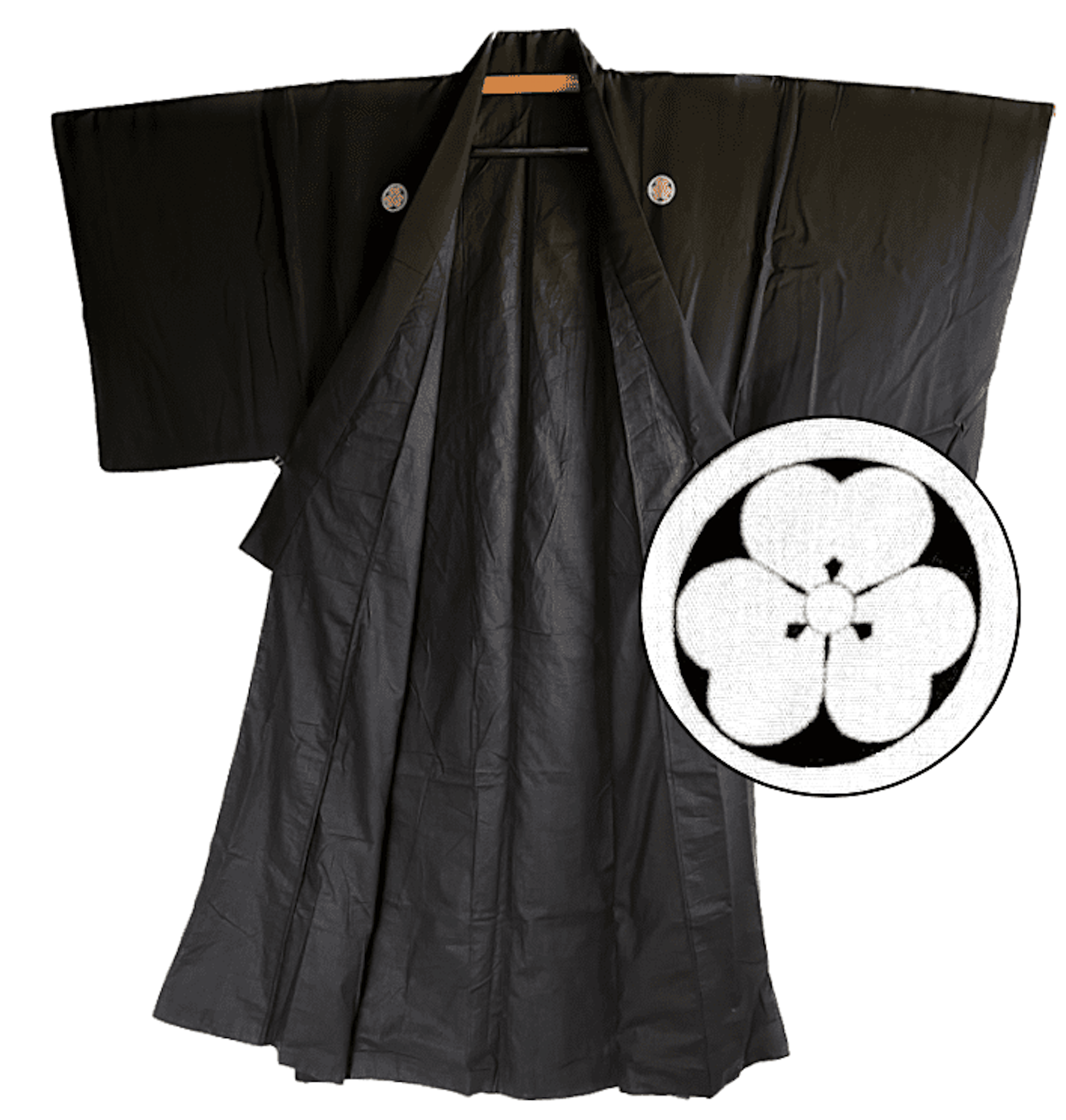 The kimono for men has undergone a fascinating fashion evolution between the 8th century and the contemporary era. Initially a unisex cotton undergarment during the Heian period, it gradually became a sophisticated garment reflecting the social status of the wearer.
The kimono for men has undergone a fascinating fashion evolution between the 8th century and the contemporary era. Initially a unisex cotton undergarment during the Heian period, it gradually became a sophisticated garment reflecting the social status of the wearer.
From the 12th century, the male kosode is distinguished by more fitted cuts and a shortened length up to the ankles. The obi belt becomes an essential element to maintain the new structure of the garment. The sleeves are refined and slightly tapered to facilitate movement.
During the Edo era, the refinement of the kimono had no limit but the inventiveness of craftsmen and dyers. Fabrics become more elaborated, often in finely spun and dyed silk. The cuts become more structured and angular, with characteristic armholes.
In the Meiji period, Western acculturation even influences the conservative male kimono. It opens slightly at the bottom, approaching the "A" silhouette of European suits. However, this fashion is short-lived.
Nowadays, the Japanese men's kimono modernizes certain details while preserving the form and traditional spirit inherited from centuries of fashion evolution. A perfect blend of Japanese continuity and modernity.
Cultural Significance
Much more than a simple garment, the kimono for men is a condensed essence of traditional Japanese culture. Its form, patterns, and colors are loaded with meaning within Japanese society.
Worn during numerous ceremonies and festivities, the kimono conveys the social status and age of the wearer. For example, a young man would not have the right to wear certain patterns reserved for married individuals or patriarchs of noble families.
Similarly, the colors used deliver a coded message about the individual's personal situation. Grey and black are worn during a period of mourning, while bright red is prohibited for unmarried men.
Furthermore, each stylistic detail of the kimono holds a unique meaning. The five family emblems of Mon - cherry, plum, bamboo, orchid, and chrysanthemum - placed on the garment, for example, symbolize Confucian virtues.
In short, guided by secular social codes and Japanese traditions, the kimono for men carries within it a condensed history of the country's cultural heritage, accessible to the initiated.
The Japanese Men's Kimono and Ceremonies
In traditional Japanese ceremonies, the kimono for men plays a central role, reflecting respect for traditions and the individual's elegance. More formal than the summer yukata, the ceremonial kimono conveys the importance of the event in which the man participates.
During seasonal festivals such as Oshogatsu or Obon, the speckled cotton kimono called Jinbei is required. For Shinto weddings, however, the refined Montsuki in silk is required for the most honored male guests. This ceremonial kimono proudly displays the wearer's family crest.
The style, fabrics, and patterns of the worn kimono thus become as many marks of deference towards the country's ancient customs. They testify to the deep respect shown by the Japanese people for the spirit of its centuries-old traditions.
Modernity and Tradition
Today, the kimono blends tradition and modernity, with new patterns and styles that reflect contemporary trends while preserving the essence of Japanese tradition.
Japanese designers are doubling their creativity to refresh the image of the kimono while respecting its age-old dress codes. Thus, we see the emergence of graphic prints, bold mixes of bright colors, and innovative fabrics like silk crepe.
Some stylists even dare to revisit the cuts by proposing shorter models, worn over trousers for casual occasions. This fashion of the "heko obi", tying the belt in front, is particularly spreading among the younger generations.
Whether worn in a classic or more contemporary way, the Japanese men's kimono skillfully preserves its traditional soul while seamlessly anchoring itself in modern Japanese life.
3) What are the Types of Traditional Japanese Kimono for Men ?
- Men's Yukata is a casual summer Japanese kimono made of light cotton or linen.
- Men's Haori is a type of traditional Japanese jacket worn over a kimono. It is usually made of silk or synthetic fabric and is worn by both men and women. The haori is similar to a Western suit jacket.
- Men's Hanten is a similar type of jacket but made of cotton or lightweight synthetic fabric and is less formal.
- Men's Happi: a casual short-sleeved kimono worn at festivals or other celebrations.
- Men's Hanten is a type of traditional Japanese jacket resembling the style of a haori, but is generally made of cotton or lightweight synthetic fabric and is less formal than a haori. It is often worn over a kimono, yukata, or other traditional Japanese clothing, and is generally worn by both men and women.
- Men's Juban is an undergarment worn under a Japanese kimono. It is usually made of lightweight silk or synthetic fabric and is worn to prevent sweat and oils from staining the outer kimono. Juban also helps to protect the outer kimono from wear.
- Men's Iromuji is a formal, solid-color Japanese kimono worn for more formal occasions, such as weddings or tea ceremonies.
- Men's Montsuki Kimono is a formal black Japanese kimono with a white collar and five crests
- Shokko Kimono for men is a formal full-length Japanese kimono worn by men for traditional Japanese performances.
4) What are the Types of Traditional Japanese Kimono Fabrics for Men ?
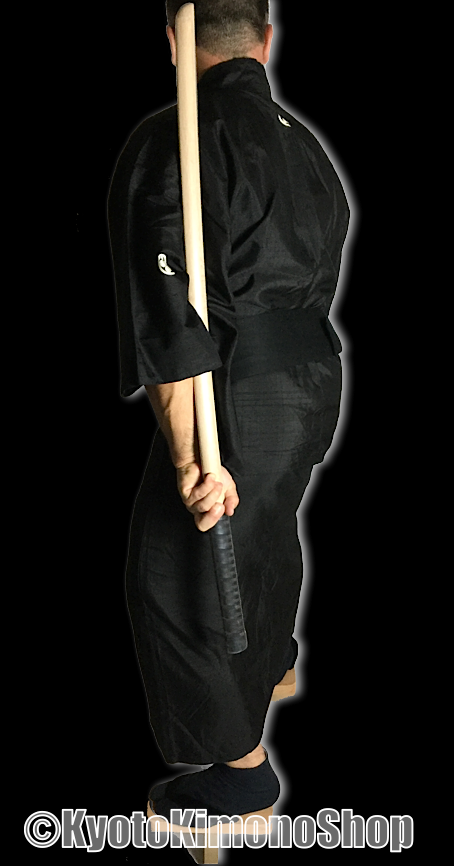
Discover the various fabrics used in the making of traditional Japanese men's kimonos, a key element of Japanese culture and sartorial elegance.
Here are the main types of fabrics used to make traditional Japanese men's kimonos:
- Natural Silk: The king fabric of formal and ceremonial kimonos. Varieties like shusu, rinzu, or bian satin.
- Cotton: For casual summer kimonos (yukata) or indoor wear (jinbei). Varies in fineness depending on use.
- Hemp: A durable plant fiber used for winter montsuki or work kimonos.
- Silk Crepe: A fabric with elastic properties allowing a close fit to the body. Used among others for hakamas or linings.
- Wild Silk: Irregular texture, giving an elegant look and natural drape to the fabric. Reserved for high-end kimonos.
- Mottled Crepe: In cotton or silk, with an embossed pattern. For mid-range outfits or richly patterned inner linings.
- Blended Silk: Combining silk and polyester for a shiny and affordable finish. Intended for contemporary yukatas or versatile kimonos.
Fabric choice depends on the desired kimono style, its intended use, and available budget. Some extremely fine and precious silk types can even cost thousands of euros per roll!
Modern and practical options for traditional jackets, offering ease of care and durability.
See: Men's Formal Antique Haori
4) What are the Different Types of Silk for Traditional Formal Japanese Kimonos (Kamon) for Men ?
Traditional formal Japanese kimonos for men, adorned with family crests or "kamon," are often made with high-quality black silk types. Here are some of the most commonly used silk types for these kimonos:
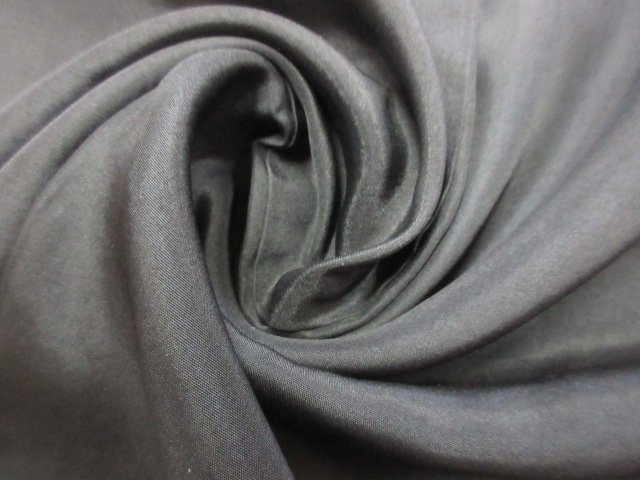 Habutae (羽二重): This silk is fine and smooth, with a soft touch and a shiny appearance. It is often used for high-quality kimonos due to its light texture and subtle sheen.
Habutae (羽二重): This silk is fine and smooth, with a soft touch and a shiny appearance. It is often used for high-quality kimonos due to its light texture and subtle sheen.- Chirimen (縮緬): This silk type has a distinctive crêpe texture resulting from a unique weaving process. Chirimen is valued for its durability and ability to maintain vibrant colors and detailed patterns.
- Tsumugi (紬): Made from irregular silk thread, this silk has a characteristic texture and slightly rough appearance. It is often used for more casual-style kimonos but can also be used for formal wear, particularly when seeking a rustic and authentic aesthetic.
- Omeshi (御召): A variety of chirimen, known for its compact and thick texture. Omeshi is renowned for its resilience and ability to maintain its shape, making it ideal for formal occasions.
- Fukuro obi (袋帯): Although primarily used for kimono belts, this silk type can also be incorporated into formal kimonos. It is known for its rich texture and decorative pattern.Note that for official ceremonies, kimonos are often adorned with specific patterns and kamon (family crests), adding to their formality and cultural significance. Choosing the right silk type is crucial not only for tradition adherence but also for the appearance and comfort of the outfit.
- Shusu: Plain weave silk, with a soft and silky touch. Used for winter kimonos or linings.
- Rinzu: Patterned silk, reserved for prestigious ceremonial kimonos.
- Bian Satin: Silk crepe with a shiny appearance, for refined men's kimonos.
- Wild Silk: Irregular texture, giving a chic and natural finish. For high-end kimonos.
- Silk Gauze: Very thin and transparent, often used in layers for kimonos on grand occasions.
5) How to Wear and Maintain a Kimono?
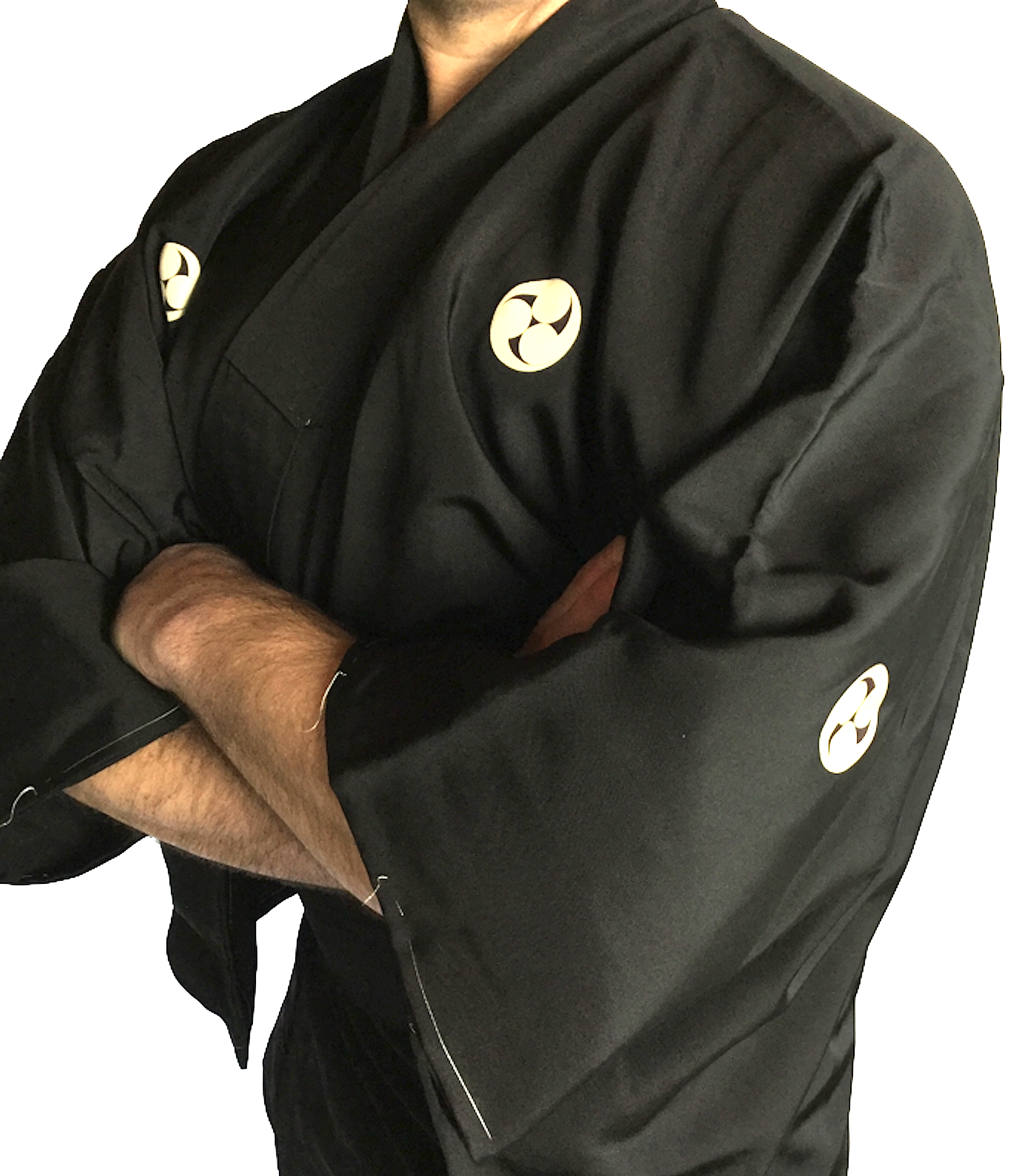 Wearing a Japanese men's kimono is an art in itself, reflecting tradition and respect for customs. Here are the key steps:
Wearing a Japanese men's kimono is an art in itself, reflecting tradition and respect for customs. Here are the key steps:
Tips for wearing a traditional Japanese men's kimono:
- - Start by putting on the juban, a kind of white inner robe that protects the kimono.
- Then put on the kimono itself, left side over right side. The front panels should overlap by about 20 cm.
- Tie the obi belt tightly around the hips, placing the knot at the back. The obi keeps the kimono in place.
- For a perfect effect, add a seasonal haori jacket to match the yukata or kimono, and possibly a hakama (pleated skirt-pants).
- Ensure that the kimono collar reveals the pristine white of the underlying juban at the back and shoulders.
- Walk in small steps to avoid undoing the obi knot at the back and to prevent stepping on the hem of the garment.
- Always consider the patterns, colors, and sleeve lengths appropriate for your age and the occasion.
Japanese Men's Kimono Maintenance
Caring for your men's kimono is essential to preserve the quality and longevity of this delicate traditional garment. Before each use, inspect the fabric for snags or stains, and have them repaired if necessary by a professional. When wearing, avoid contact with liquids and direct sunlight for extended periods. After use, air out the kimono away from light for a few hours to eliminate sweat. Then use a soft brush to remove dust and fluff. Cleaning the kimono should generally be entrusted to a specialized service, depending on the type of fabric. Silk, in particular, requires very delicate dry cleaning. For storage, fold the kimono carefully using traditional techniques, possibly using tissue paper. Place it flat in a cotton cover away from moisture and insects. With these few steps after each use, your Japanese men's kimono will retain all its charm and centuries-old tradition. A kimono requires special care to preserve its quality and beauty.
6) Different Uses and Occasions
Daily Use and Special Occasions
The Japanese men's kimono comes in several styles, each corresponding to specific situations and events in traditional Japanese life. For relaxed indoor activities, the cotton jinbei is perfect. The yukata, meanwhile, is worn in summer for city walks or in ryokans.During seasonal festivals like Hanami or summer festivals, then your finest cotton yukata, often with colorful patterns, is worn.
Ceremonies of passage - funerals, weddings, graduations - require the dressed kimono known as "Montsuki". Its black or gray silk is then adorned with the family emblem to affirm clan affiliation.
Finally, for New Year or significant official events, the complete "Kitsuke" outfit is required: silk kimono, short haori jacket, and hakama skirt-pants.
Thus, throughout annual occasions or life stages, the Japanese proudly wear the appropriate men's kimono to convey tradition and elegance.
Practical Tips
Japanese Men's Kimono and Martial Arts:
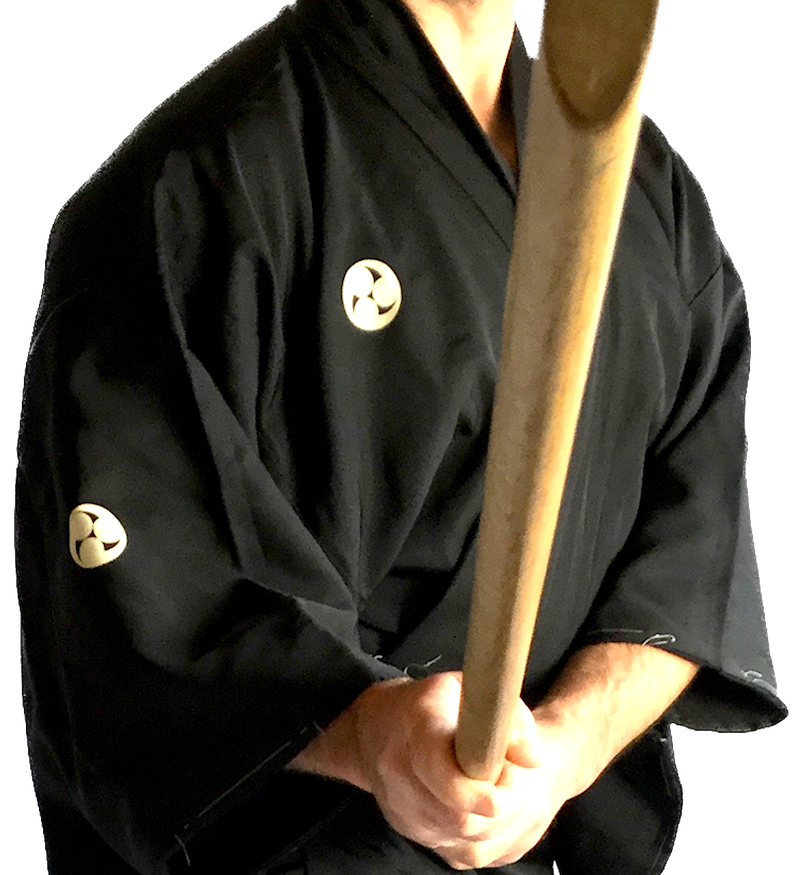 In Japan, martial arts such as judo, karate, or kendo are closely associated with certain traditional outfits derived from the men's kimono. These outfits, called "keikogi" or "dogi", reflect the spirit of Japanese budo.
In Japan, martial arts such as judo, karate, or kendo are closely associated with certain traditional outfits derived from the men's kimono. These outfits, called "keikogi" or "dogi", reflect the spirit of Japanese budo.

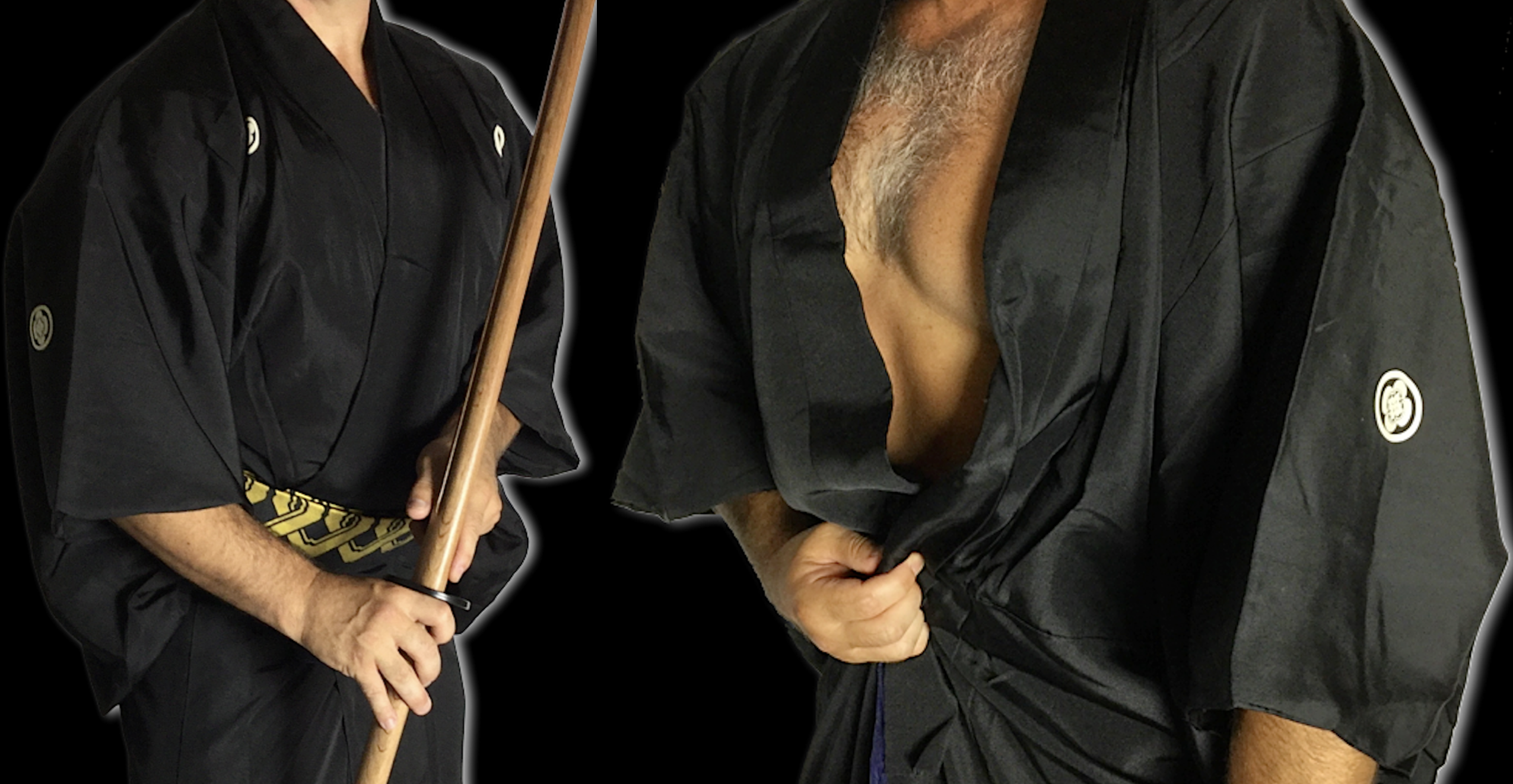


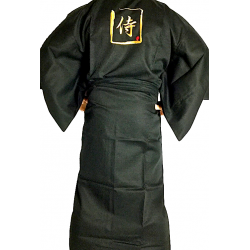

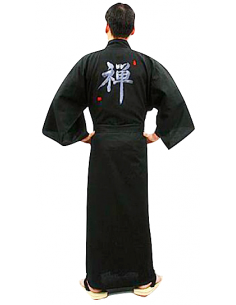

Comments (0)